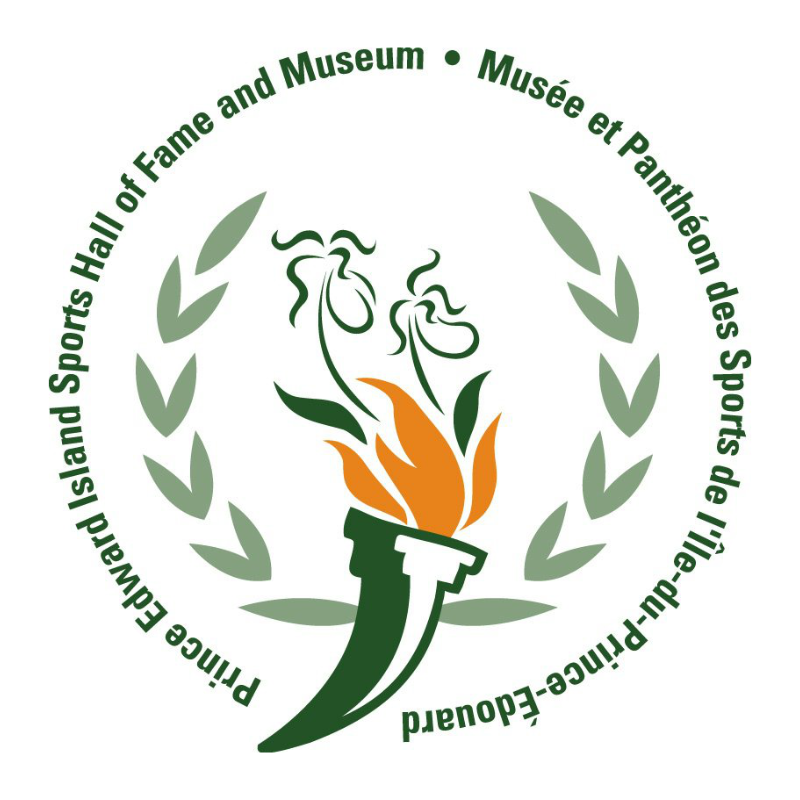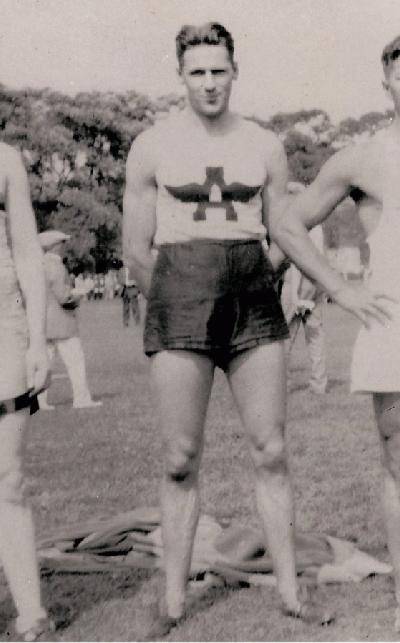Philip Blake Macdonald was born in 1904, the only son among Laughlin and Minnie Macdonald’s three children. It was a close-knit, spiritual family, staunch members of Charlottetown’s Zion Presbyterian Church. But sports and religion were compatible interests for the Macdonalds; one disciplined the spirit, the other, the body. Phil’s father, a ladies’ tailor, had won a number of track-and-field medals at the local Caledonian Games in his youth, and his son showed an early interest in athletics.
After dominating a number of schoolboy meets in Charlottetown, Macdonald was recruited by the Abegweits for the 1921 season. His first major exposure came on July 1, 1921 at the Dominion Day celebrations at Summerside. Performing in front of over 8,000 people, Macdonald responded with a first-place jump of 18′ 9″ in the broad jump and a second place finish in the high jump. At 17 years of age, Macdonald was demonstrating a remarkable talent as a jumper. Endowed with a strong, linear physique and possessed of unusual modesty and dedication, he quickly established himself as the dominant athlete in Maritime track-and-field circles. In September 1921, he helped the Abbies win the Maritime track and field championships at Saint John, New Brunswick. In July 1922, he was back at Summerside to establish a Maritime record in the broad jump at 22′ 1″. At the 1923 championships in Halifax, the Abegweit team provided much of the excitement, winning the meet with 44 points. Phil Macdonald created a stir when he unleashed a broad jump in the vicinity of 22′ 10″,
only to have a well-meaning official rake the pit before the jump could be measured for record purposes.
Track and field’s high profile continued into the 1923 season with Macdonald now leading one of the strongest track-and-field teams ever assembled in the Maritime region. The Abegweit Club won a resounding victory at the Maritime Championships in Moncton in August, and in September it gave its best performance to date in national competition at the Canadian Track and Field Championships in Halifax. Macdonald amassed 16 points for the meet’s second highest individual aggregate, and demonstrated his versatility by winning the hop, step and jump; finishing second in the running broad jump, standing broad jump, and standing high jump; and coming third in
both the 120-yard hurdles and discus.
By the end of the 1923 season, with his reputation as a track-and-field athlete well established throughout eastern Canada, Macdonald began preparation for his ultimate challenge, the Olympic Games in Paris in July 1924. Under Halpenny’s [inducted 1970] guidance, his progress had been amazing. Still in his teens, he was a Canadian champion, a Maritime record-holder, and had shown he was capable of competing at the national level in at least five events.
When the Canadian Olympic Committee established regional training camps in the spring of 1924, Macdonald was invited to the Maritime Camp at Rothesay, New Brunswick. Captain J. R. Cornelius, coach of the Canadian team, visited the Rothesay camp. He was impressed with Macdonald and identified him as a potential 400 meter hurdler. Cornelius sought permission from the Maritime Provinces Branch of the Amateur Athletic Union of Canada (MPBAAUC) to have Macdonald transferred to the Ontario camp so that he could receive proper coaching in the hurdles event. MacDonald had never run the 400 meter hurdles before, but when asked if he would
consider training for the hurdles in addition to jumps, his response (as quoted by the Canadian Press) was characteristic:
“I will do anything the Committee wants me to do: I am eager to do all I can to put the Maritimes on top.”
Aside from the Olympic Trials in Montreal, Macdonald had never raced outside the Maritimes, and the impact of the huge crowds in Paris must have been overpowering. Moreover, his race was the first event on the first of six heats in the first event on the first day of the Games. There were three runners in each heat. The semi-finalists would be decided by place of finish, not times, and only the first two finishers in each heat would advance. C. R. Brookins of the United States, the eventual bronze medalist, narrowly won the heat in 54 4/5 seconds. Macdonald finished a close third. Even though the time was only 3/4 of a second off the world record, the fastest than
one of the semi-finals – Macdonald’s third-place finish eliminated him from further competition. His Olympic career had lasted less than a minute. Even in defeat, Macdonald’s had been a remarkable showing, and he was singled out for special praise by Cornelius in his post-Games report to the Canadian Olympic Committee.
Phil Macdonald’s career did not end at Paris. In the years following the 1924 Olympics, he continued to compete – and excel – with his old track and field club. In the 1924 Maritime Championships, Macdonald set a new record and tied the Canadian mark in the 120-yard hurdles with a time of 15 3/5 seconds in a meet held at the Abegweit Grounds. At the Canadian Championships in Halifax that September, he won the hop, step and jump and the running broad jump, while placing second to his old nemesis, J.
W. Montabone of Montreal in the 120-yard hurdles. Altogether, he and teammate Wallie Scantlebury [inducted 1983] combined for 14 points, maintaining the Abegweit presence in national competition.
Although “specialization” had become the watchword in track-and-field competition following the 1924 Olympics, Phil Macdonald continued his practice of participating in a number of events. In the 1926 Maritime Championships, he won three events and placed second in another. At the 1927 meet, he ran wild, competing in seven events and amassing 25 points as he led the Abegweit Club to its 13th consecutive Maritime
Track and Field Championship. Following this impressive performance, Macdonald was invited to the 1928 Olympics Trials, which were slated for Toronto in late August 1927.
Why Macdonald chose to continue competing in many events instead of specializing in one or two is a matter for conjecture. It is obvious that he enjoyed competition immensely, and the freedom to run, jump, and throw seems to have exceeded his desire to dominate in a single events. Furthermore, he apparently placed team honors above personal achievement; his individual aggregate points contributed substantially
to the Abegweit team victories between 1920 and 1927. Finally, with Halpenny’s departure, the technical coaching needed to concentrate his talents just was not there.
In terms of national competition, the decision not to specialize was probably detrimental. Macdonald finished second in the 120-yard hurdles at the Trials. The time
– 15 3/5 seconds – equaled his Maritime record established two years earlier in Charlottetown. But it was not enough. While he maintained a high level of performance in all of his events, Macdonald was not named to the 1928 Canadian Olympic Team.
By the late ’20’s, the once-powerful Abegweit track-and-field program was fading. It was primarily on the performances of a single individual, Phil Macdonald, that the
Abegweits had been able to dominate track and field during the 1920’s. By 1927, he had competed in eight Maritime Championships, finishing high individual athlete in six of them. He held two Maritime records, one Canadian mark, and numerous Canadian championship titles; and at the Olympics he had brushed shoulders with the best
athletes in the world. But by 1928, leadership in amateur sport and interest in track and field were both at a low ebb throughout the Maritimes. It was not a time for
hanging on.
The Olympic trials in 1927 was Macdonald’s last major meet. While he was undoubtedly disappointed in not being selected for the Canadian team, it is equally unlikely that the feeling lingered. At the time, he was employed by the Royal Bank in Charlottetown, and the following year he moved to Toronto where he established a business career as a lumber broker.
Perhaps more than any other Island athlete, Phil Macdonald exemplified the spirit and dominance of the Abegweit Association in Maritime track and field. He was talented, dedicated, modest, and, above all, a leader by example.
Nor did Macdonald live on memories. Few of his later friends or family knew much about his extradinaory sports career. But others remembered. In 1969, 42 years after
he finished his athletic career, Macdonald was accorded the highest honor for sports achievement that could be bestowed by his fellow Islanders: he was inducted into the
Prince Edward Island Sports Hall of Fame. “My cup runneth over,” he said simply.
Philip Blake Macdonald died on January 4, 1978.
Updated: December 2006
Updated: October 2015
File Contains: Canadian vest and shorts; running spikes; numerous medals; silver cups (on file and on display); 1924 Olympiad report book; Olympic reception invitation; 1924 Olympic participants medal (on display); in depth article by Charlie Ballem entitled “Our Phil: Road to the Olympics”; copy of citation; telegram from the Abegweit Athletics Club; Macdonald letter from 1975; numerous photos; numerous press clippings; photo of the 1924 Abegweits Maritime Champions; 1921 Abegweits picture; framed participation certificate from 1924 Olympics



